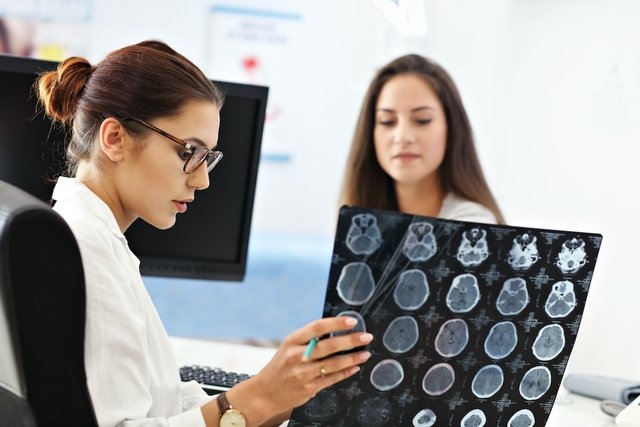Huntington’s disease is a rare hereditary disease that causes progressive degeneration of brain neurons, causing disturbances in movement, behavior and the ability to communicate, and symptoms such as muscle spasms, changes in balance or difficulty speaking or swallowing.
The symptoms of this disease, also known as Huntington’s chorea, are progressive and can begin between the ages of 30 and 50, but can also begin in childhood or adolescence, before the age of 20, in which case it is called juvenile Huntington’s disease.
The treatment of Huntington’s disease is carried out by a neurologist, and usually involves the use of medicines that help alleviate symptoms, as well as psychotherapy, physiotherapy and occupational therapy, to improve quality of life.

Huntington’s disease symptoms
The main symptoms of Huntington’s disease are:
- Rapid involuntary movements, called chorea, which begin localized in one member of the body, but which, over time, affect several parts of the body;
- Muscle spasms or contortions;
- Stiffness, tremor or muscle contractions;
- Slow eye movements;
- Difficulty moving and slow movements;
- Difficulty walking or standing, which can lead to falls;
- Difficulty speaking and swallowing, increasing the risk of choking and aspiration pneumonia;
- Difficulty organizing, focusing and planning tasks;
- Memory loss;
- Impulsiveness;
- Irritability, which can lead to explosive behavior and aggression;
- Feeling of sadness or lack of feeling or emotion;
- Lack of attention;
- Slow thinking and difficulty finding words;
- Difficulty learning new information;
- Excessive tiredness and lack of energy;
- Insomnia;
- Unintentional weight loss;
- Depression;
- Psychosis;
- Suicidal tendency.
These symptoms can vary from person to person and may evolve more quickly or be more intense depending on whether or not treatment is carried out.
In the presence of signs and symptoms indicative of Huntington’s syndrome, especially if there is a family history of the disease, it is important to consult a general practitioner or neurologist for an evaluation, as well as tests, so that treatment can begin.
Symptoms of Juvenile Huntington’s Disease
The symptoms of juvenile Huntington’s disease may be slightly different from those in adults and include:
- Frequent falls or trips;
- Speech and language delay;
- Slurred speech;
- Learning difficulties;
- Rapid and significant decrease in school performance;
- Behavioral problems;
- Tremors;
- Mild involuntary movements;
- Seizures.
These symptoms can affect children or adolescents, appearing progressively, before the age of 20. Furthermore, in the case of adolescents, behavioral symptoms and chorea are usually the initial symptoms.
How to confirm the diagnosis
The diagnosis of Huntington’s disease is made by a neurologist or general practitioner, or neuropediatrician in the case of children and adolescents, through evaluation of symptoms, family history of the disease, and physical, neurological and psychiatric examination.
In addition, the doctor may order a computed tomography exam, which allows the affected region of the brain to be assessed, and help rule out other diseases with similar symptoms, such as tardive dyskinesia, cerebral lupus, Wilson’s disease, aceruloplasminemia or McLeod syndrome, for example. .
Another test that the doctor may order to confirm the diagnosis of Huntington’s disease is a genetic test with the aim of identifying the mutation responsible for the disease.
If one of the parents has Huntington’s disease, the diagnosis can be made through prenatal tests, such as chorionic villus sampling, between the 1st and 12th weeks of pregnancy, or amniocentesis, between the 15th and 17th weeks. of pregnancy. See how amniocentesis is performed.
Possible causes
Huntington’s disease is caused by a genetic alteration, which is passed on hereditarily, and which determines the degeneration of important regions of the brain. The genetic alteration of this disease is of the dominant type, which means that it is enough to inherit the gene from one of the parents to have the risk of developing it.
Thus, as a consequence of genetic alteration, an altered form of a protein is produced, which results in the death of nerve cells in some parts of the brain and favors the development of symptoms.
How the treatment is carried out
The treatment of Huntington’s disease must be carried out under the guidance of a neurologist and psychiatrist, with the aim of reducing symptoms and improving quality of life.
Therefore, the treatments that may be recommended by the doctor are:
1. Use of medicines
The use of medicines aims to treat movement disorders and psychiatric disorders, and includes:
- Medicines that control movement changessuch as tetrabenazine or amantadine;
- Antipsychoticssuch as haloperidol, fluphenazine, olanzapine, quetiapine, or aripiprazole;
- Antidepressantssuch as sertraline, citalopram, or mirtazapine;
- Mood stabilizerssuch as carbamazepine, lamotrigine, or valproic acid.
These remedies help to treat symptoms, but do not prevent the disease from progressing, and must be used with a doctor’s advice, with regular medical consultations being necessary to evaluate the treatment.
2. Psychotherapy
Psychotherapy and cognitive behavioral therapy aim to help deal with behavioral problems, developing tools to face the moments when symptoms arise.
Furthermore, psychotherapy is important to help the person face the disease and deal with expectations regarding the evolution of the disease.
3. Physiotherapy
Physiotherapy aims to strengthen muscles, improve the way of walking, balance and motor coordination, and train activities of daily living such as walking, in order to avoid falls, and other activities according to the person’s needs.
4. Occupational therapy
Occupational therapy can also help improve quality of life, reducing the difficulty in moving or doing simple daily activities, such as eating or walking, for example.
This is because, in occupational therapy sessions, the professional helps the person to use some auxiliary equipment, such as special cutlery or a wheelchair, which allows them to perform the same tasks, even when the disease is limited.
5. Speech therapy
Speech therapy is indicated to help improve control of speech and swallowing muscles, improving the ability to speak, eat and swallow, preventing complications such as choking or aspiration pneumonia.

Sign up for our newsletter and stay up to date with exclusive news
that can transform your routine!
Warning: Undefined array key "title" in /home/storelat/public_html/wp-content/plugins/link-whisper-premium/templates/frontend/related-posts.php on line 12
Warning: Undefined array key "title_tag" in /home/storelat/public_html/wp-content/plugins/link-whisper-premium/templates/frontend/related-posts.php on line 13



